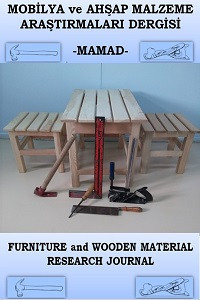Karaçam testere talaşının polipropilen kompozitlerin mekanik özelliklerine etkisi
Günümüzde çevreye olan duyarlılıktaki artış ile birlikte atık maddelerin geri dönüştürülebilme konuları üzerine araştırmalar yapılmaktadır. Bu çalışmada polipropilen (PP) polimer matrise ilave edilen farklı oranlardaki karaçam testere talaşından elde edilen kompozit malzemelerin mekanik özelliklerindeki değişiklikler incelenmiştir. Kompozit üretimi için karaçam testere talaşı ile PP polimer matrisi çift burgulu ekstruder kullanılarak kompozit pelletleri formuna dönüştürülmüştür. Elde edilen pelletlerden sıcak pres kalıplama tekniği ile 250x250x2 mm ebatlarında kompozit levhalar üretilmiştir. Daha sonra üretilen kompozit levhaların ASTM standartlarına göre çekme, eğilme ve darbe direnci testleri yapılmıştır. Mekanik test sonuçlarına göre en yüksek çekme direnci değeri %10 odun unu ilaveli kompozit örneğinde, en yüksek eğilme direnci ise %50 odun unu ilaveli kompozit örneğinde tespit edilmiştir. Ayrıca kompozitler arasında en yüksek darbe direnci, %20 odun unu ilaveli kompozit örneğinde elde edilmiştir.
Anahtar Kelimeler:
karaçam, testere talaşı, PP, kompozit, mekanik özellikler
Effect of black pine sawdust on the mechanical properties of PP composites
Today studies on the recycling of waste materials increasingly gaining importance and increasing with the growing sensitivity to the environment. In this study, the changes in the mechanical properties of composite materials produced by adding the black pine sawdust with the polypropylene polymer matrix at different ratios were investigated. For the production of composite, black pine saw dust mixed with PP polymer and then, they were converted into pellets using twin-screw extruder and combined pelletizer. The obtained pellets were molded into composite boards in 250 x 250 x 2 mm dimensions via hot press molding technique. Then tensile, bending and impact resistance tests of composite boards produced were carried out according to ASTM standards. According to the results of the mechanical tests, the highest tensile strength value was found for the composite sample of 10% wood flour loaded composite, while the highest bending strength was found for the composite with 50% wood flour. In addition, the highest impact resistance was obtained for the 20% wood flour added sample among all composites.
Keywords:
black pine, sawdust, PP, composites, mechanical properties,
___
- Ashori, A. (2008). Wood–plastic composites as promising green-composites for automotive industries, Bioresource Technology, 99(11): 4661-4667.
- ASTM, D638. (2001). Standard test methods for tensile properties of plastics, American Society for Testing and Materials.
- ASTM, D790. (2003). Standard test methods for flexural properties of unreinforced and reinforced plastics and electrical insulating materials, American Society for Testing and Materials.
- ASTM, D256. (2005). Standard test methods for impact resistance of plastics and electrical insulating materials, American Society for Testing and Materials.
- ASTM, D4703-10. (2010). Standard practice for compression molding thermoplastic materials into test specimens, plaques, or sheets, American Society for Testing and Materials.
- Bhaskar, J., Haq, S., Pandey, A., & Srivastava, N. (2012). Evaluation of properties of propylene-pine wood plastic composite, Journal of Materials and Environmental Science, 3(3): 605-612.
- Bromhead, A. (2003). Reducing wood waste in furniture manufacture, Fauna & Flora International, Cambridge, UK.
- Caulfield, D.F., Clemons, C., Jacobson, R.E., & Rowell, R.M. (2005). 13 Wood Thermoplastic Composites. Handbook of wood chemistry and wood composites: 365.
- Hull, D., & Clyne, T. (1996). An introduction to composite materials, Cambridge University Press, UK, 326 s.
- Klyosov, A.A. (2007). Wood-plastic composites, John Wiley & Sons, Inc., Hoboken, New Jersey, 720s.
- Kumar, R., Obrai, S., & Sharma, A. (2011). Chemical modifications of natural fiber for composite material, Der Chemica Sinica, 2(4): 219-228.
- Mallick, P.K. (2007). Fiber-reinforced composites: materials, manufacturing and design, CRC press, USA, 638 s.
- Pritchard, G. (2004). Two technologies merge: wood plastic composites, Reinforced Plastics, 48(6): 26-29.
- Schwarzkopf, M.J., & Burnard, M.D. (2016). Wood-Plastic Composites-Performance and environmental impacts. Environmental impacts of traditional and innovative forest-based bioproducts, Springer, pp. 19-43.
- Sofuoğlu, S.D., & Kurtoğlu, A. (2006). Masif ağaç malzemenin işlenmesinde fire oranları. Dumlupınar Üniversitesi Fen Bilimleri Enstitüsü Dergisi, 11: 189-204.
- Smith, P.M., & Wolcott, M.P. (2006). Opportunities for wood/natural fiber-plastic composites in residential and industrial applications, Forest Products Journal, 56(3): 4-11.
- Stark, N.M., & Matuana, L.M. (2004). Surface chemistry and mechanical property changes of wood-flour/high-density-polyethylene composites after accelerated weathering, Journal of Applied Polymer Science, 94(6): 2263-2273.
- Yayın Aralığı: Yılda 2 Sayı
- Başlangıç: 2018
- Yayıncı: Bekir Cihad BAL
Sayıdaki Diğer Makaleler
Karaçam testere talaşının polipropilen kompozitlerin mekanik özelliklerine etkisi
Nasır NARLIOĞLU, Nihat Sami ÇETİN, Mehmet Hakkı ALMA
Zebrano, sapelli ve merbau odunlarının renk ve parlaklık özellikleri üzerine ısıl işlemin etkisi
Ümit AYATA, Tuğba GÜRLEYEN, Levent GÜRLEYEN
Ümit AYATA, Tuğba GÜRLEYEN, Levent GÜRLEYEN, Nevzat ÇAKICIER
Kayın ve kavak odunlarında bazı fiziksel özelliklerle yoğunluk ilişkisinin belirlenmesi
